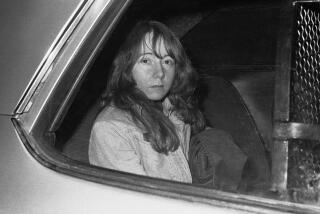Doing justice to an assassin
- Share via
“AWFUL EVENT” blared the headline in a leading U.S. newspaper. Indeed, the mortal wounding of President Abraham Lincoln on April 14, 1865, was one of the worst occurrences in the country’s history, from its founding even to the present day.
A reunited nation had just passed through four years of a “fiery trial” that took the lives of 620,000 men. The larger secessionist army had surrendered, and although some Confederate troops were still in the field, Gen. Ulysses S. Grant was dismantling the Union armies.
The people of Washington were celebrating wildly. Lincoln and his wife were to make a well-publicized appearance at Ford’s Theatre to see the play “Our American Cousin.” Everyone knows what happened that Good Friday evening: how John Wilkes Booth of the famous acting family shot the president in the head, leaped from the box to the stage shouting, “Sic semper tyrannis!” and rode into the night on a waiting horse.
Government authorities moved quickly; the conspiracy Booth had woven was unraveled, its members captured. Booth was shot to death 12 days later by a Union sergeant in a burning barn on the Virginia farm where he had been hiding from numerous search parties.
In “American Brutus,” Michael W. Kauffman, an independent historian, treads the familiar ground of the assassination again, justifying his return with the claim to have established once and for all what happened and which details are accurate. He makes a good case for considering his book the last word on the nearly 140-year-old crime.
Kauffman has examined all the extant records and the various testimonies. The main lines of the story remain unchanged. On various disputed points, he concludes that Booth’s leg bone was broken not when he landed on the stage but as he rode away; that he definitely did not shoot himself; that Mary Surratt should not have been one of the four conspirators hanged, for she was not as deeply involved as alleged, and that Dr. Samuel Mudd, who treated Booth for his broken bone, was not part of the conspiracy and should not have been imprisoned. His conclusion about Mudd is relevant because his descendants recently tried and failed to have his name judicially cleared.
One of Kauffman’s main points is that Booth wove a shadow conspiracy of “smoke and mirrors” to conceal the real plot and that Booth implicated several men in this false conspiracy to distract attention from those who were helping him to assassinate Lincoln, and in the simultaneous attempted murder of Secretary of State William H. Seward at his nearby home as well as a misfired plan to murder Vice President Andrew Johnson.
Kauffman does little to expand our understanding of Booth’s character and motivation, but he provides some glimpses, including a letter he wrote to his mother while on the run. The letter, found after his death, said he would rather die than give her pain, but he added, “[T]here is another duty, a noble duty for the sake of liberty and humanity due my country.... Uncontrollable fate, moving me for its ends, takes me from you, dear Mother, to do what work I can for a poor oppressed downtrodden people.”
Booth saw himself as a latter-day Brutus ridding the world of a tyrannical Julius Caesar, Kauffman writes. But the American people compared Lincoln, shot on Good Friday, not to a murdered tyrant but to an assassinated savior.
Booth’s brother, Edwin, himself a famous actor, wrote to their sister soon after the assassination: “Think no more of him as your brother; he is dead to us now, as soon must be to all the world.”
Historians and encyclopedias have labeled Booth an egomaniac. For all Booth’s grandiloquent words, Kauffman’s book affirms this terse assessment of the man who caused the most awful event of all.
*
Anthony Day is a regular contributor to Book Review.
More to Read
Sign up for our Book Club newsletter
Get the latest news, events and more from the Los Angeles Times Book Club, and help us get L.A. reading and talking.
You may occasionally receive promotional content from the Los Angeles Times.







